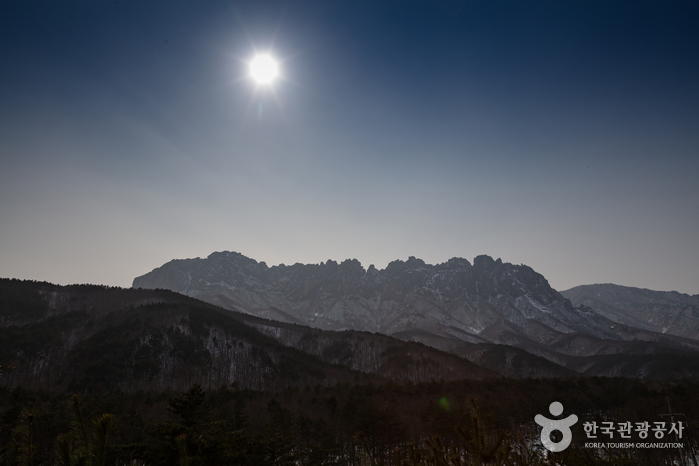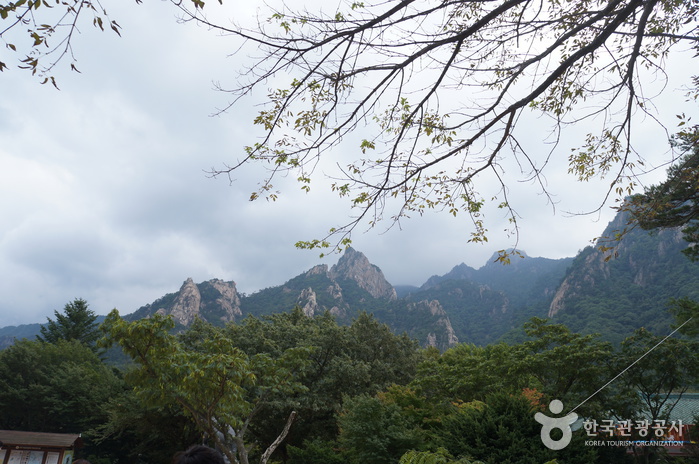Cheongganjeong Pavilion (청간정)
12.1 Km 38029 2024-03-18
5110 Donghae-daero, Toseong-myeon, Goseong-gun, Gangwon-do
Cheongganjeong Pavilion, located atop a cliff, was built during the mid-Joseon period. It is situated at the point where Cheonggancheon Stream, originating from Seoraksan and Cheonhusan Mountains, flows into the East Sea. The view of the pine forest and the East Sea draws many visitors. Nearby attractions include Cheongganhaebyeon Beach, Cheonjinhaebyeon Beach, Ayajinhaebyeon Beach, as well as Bongpo Port and Ayajin Port.
Seoraksan Ulsanbawi Rock (설악산 울산바위)
12.9 Km 50892 2024-02-28
1091 Seoraksan-ro, Sokcho-si, Gangwon-do
+82-33-680-3382
Ulsanbawi is a rock formation in Seoraksan Mountain that consists of six massive peaks, each reaching 900 meters above sea level. The name "Ulsanbawi" is derived from the shape of the peaks, which spread out like a fence, and it is located at the center of Seoraksan Mountain. This rock is celebrated for its unique shape, the scenic beauty surrounding it, and its hiking trails. It takes about three hours to reach the top of Ulsanbawi from Sogongwon Park.
Yangyang Dongho Beach (동호해변(양양))
13.5 Km 36613 2021-07-27
141-26, Dongho-ri, Yangyang-gun, Gangwon-do
+82-33-670-2787
This relatively small beach is located in Yangyang-gun, Gangwon-do. It is 500 meters in length and 55 meters in x_width, and has an average depth of 1.2 meters. The beach is particularly known for its soft and fine sand, often considered to be the best on the east coast. Despite its excellent scenery and clear water, the beach is relatively obscure and peaceful. It is only open during the daytime between July and August. The pine trees surrounding the beach are protected areas, and visitors are prohibited from entering. Surfing is another draw of the beach, and the surf shop offers lessons and equipment rentals. Scuba diving is also available on site. An interesting insight into the folk tradition is “anchovy flinging,” a traditional method of catching anchovies that involve about 70 people working together to pull a big net from the sea to land. This experience is offered free of charge during the opening of the beach, and requires payment for periods outside the vacation season. Prior reservation is required through the official website. The beach enjoys excellent access from Yangyang International Airport and a 20-min ride from Yangyang city center. Dongho-ri Beach Campground, Seoraksan Mountain, and Osaek District can be found nearby.
Ulsanbawi Rock Milky Way Photo Spot on Old Misiryeong Trail (미시령옛길 울산바위 은하수)
13.6 Km 1 2024-03-18
5110 Donghae-daero, Toseong-myeon, Goseong-gun, Gangwon-do
Misiryeong Pass, historically a pathway connecting Inje to Sokcho, also serves as an observation point for viewing Ulsanbawi Rock in Seoraksan Mountain. More recently, it has gained popularity as a photo spot for capturing the Milky Way. As a result, on clear nights, the parking lot is often filled with eager photographers.
Osaengnyeong (Hangyeryeong) Pass (오색령(한계령))
14.0 Km 9865 2021-04-12
Seo-myeon, Yangyang-gun, Gangwon-do
+82-33-672-2883
This 1,004 m-high pass connects Seo-myeon of Yangyang-gun and Buk-myeon and Girin-myeon of Inje-gun, at the border between Naeseorak and Namseorak. The people of Yangyang know the pass as Osaengnyeong, while in Inje it is known as Hangyeryeong. Yi Jung-hwan, a late Joseon period scholar and the author of the geographical text Taengniji (On Selecting a Village), counted Osaengnyeong Pass as the first and the foremost of the six famous passes in Gangwon-do. Indeed, Osaengnyeong Pass was the route through which essential supplies were transported from Yangyang (in Yeongdong) to Inje (in Yeongseo region), and the rough pass taken by the people of Yangyang on the way to Seoul. Its presence in the folklore of the region can be seen in the popular song Hangyeryeong, which speaks to the difficulties of those who had to climb the pass. Hangyeryeong Road was opened in 1981, and today’s National Road No. 44 is famous for being a driving course through the beauty of Seoraksan Mountain. This is also the starting point of the shortest route to Daecheongbong Peak, the highest peak in Seoraksan Mountain, and the trail to the summit of Jeombongsan Mountain.
Bongjeongam Hermitage (Inje) (봉정암(인제))
14.8 Km 36133 2024-02-28
1700 Baekdam-ro, Buk-myeon, Inje-gun, Gangwon-do
Bongjeongam Hermitage, situated at the highest point of Seoraksan Mountain, stands at 1,244 meters above sea level. Due to its elevation, one can witness snow-covered landscapes well into late May. The temple is 10.6 kilometers from the entrance of Baekdamsa Temple and requires 4-5 hours of steep climbing to reach. The view from Bongjeongam Hermitage is breathtaking, but the view of Seoraksan Mountain from the Shrine of Sakyamuni Buddha's Sarira is equally unmissable.
Seoraksan Daecheongbong Peak (설악산 대청봉)
15.9 Km 30864 2024-02-29
1 Daecheongbong-gil, Yangyang-gun, Gangwon-do
+82-33-672-2883
Standing at 1,708 meters above sea level, Daecheongbong is the highest peak of Seoraksan Mountain. It is the third highest peak in South Korea, after Hallasan Mountain (1,950 meters) and Jirisan Mountain (1,915 meters). The peak is a home to a variety of alpine species, including dwarf pine, Korean rosebay, and Erman's Birch, and its summit offers breathtaking views. The shortest of Seoraksan's hiking trails is the Osaek course (Osaek-Seorak Falls-Daecheongbong), which takes about four hours.
Seorak Special Tourist Zone (설악 관광특구)
16.8 Km 7795 2020-03-25
Sokcho-si, Gangwon-do
+82-33-249-2775
Seorak Special Tourist Zone is a vast zone included in 3 administrative districts, encompassing the entirety of Seoraksan Mountain. In this zone, visitors have various ways to enjoy Seoraksan Mountain and the natural environment of the East Sea region.
Sokcho, which occupies the largest area in the zone, comes first when talking about Seoraksan National Park. Tourists can appreciate the picturesque scenery of the sea and coastal lakes as well as the mountain scenery of Seoraksan Mountain. Hikers can climb the mountain or ride a cable car. Sokcho Beach is a hot spot that attracts young people who fill the place with energy and life all through the summer.
Abai Village, which appeared in several TV dramas for its unique atmosphere, and Sokcho Jungang Market offer local specialties, such as abai sundae (Korean sausage) and dak gangjeong (glazed fried chicken bites).
Goseong, which is bordered by Seoraksan Mountain and Geumgangsan Mountain, is part of the Northern Limit Line (NLL) that offers a unpolluted, beautiful landscape around the Demilitarized Zone (DMZ). Hwajinpo Beach near Hwajinpo Lake, which is a lagoon, and Songjiho Beach near Songjiho Lake are the best places to spend a peaceful vacation. At Hwajinpo Lake, tourists can visit the summer house used by the first South Korean President Syngman Rhee and Castle of Hwajinpo, visited by the former North Korean leader Kim Il-sung before the division of the Korean Peninsula. Lastly, although it is a relatively small part of Seorak Special Tourist Zone, Yangyang has resources for mountain tourism and maritime culture, such as Seoraksan National Park and Naksan Provincial Park. Naksan Beach, Naksansa Temple and Hajodae are popular tourist sites. It is also famous as a district producing high quality pine mushroom.
* Current State of Seorak Special Tourist Zone
1) Districts Covered: Areas around Sokcho-si and parts of Goseong and Yangyang-gun, Gangwon-do
2) Area: 138.2k㎡(Sokcho 104.9k㎡, Goseong 30.5k㎡, Yangyang 2.8k㎡)
* Tourist Attractions
Seoraksan National Park, Sokcho Beach, Naksan Provincial Park, Hwajinpo Lake, Songjiho Lake, Hajodae Pavilion, Naksansa Temple, Osaek Mineral Spring, etc.
Osaek Green Yard Hotel (오색탄산온천)
16.9 Km 37133 2023-10-27
34 Daecheongbong-gil, Seo-myeon, Yangyang-gun, Gangwon-do
Osaek Green Yard Hotel offers Holon Immunity Wellness, a health experience that focuses on Holon immunity, wellbeing, happiness, and fitness. The hotel is located in a forest at an altitude of 647 m, perfect for rest and relaxation. The hotel also uses natural mineral water with a 21.5-23% higher concentration of oxygen for speedy recovery. Guests can enjoy the view of Seoraksan National Park from their rooms.
Osaek Sikdang (오색식당)
17.1 Km 15511 2024-02-16
58-120 Daecheongbong-gil, Seo-myeon, Yangyang-gun, Gangwon-do
033-672-3180
Situated by the Osaegyaksuteo Mineral Spring on Seoraksan Mountain, Osaek Sikdang is celebrated for its Yaksu gamasot jeongsik (dish cooked in a cast-iron pot set menu), which is uniquely prepared using mineral spring water from Seoraksan Mountain. The iron content in the water gives the rice a distinctive, almost blue hue. Another popular item on the menu is the Sanchae jeongsik (wild vegetable dish set menu), comprising about 12 side dishes made with seasonal wild vegetables harvested from Seoraksan Mountain, offering a taste that varies with the seasons.



 English
English
 한국어
한국어 日本語
日本語 中文(简体)
中文(简体) Deutsch
Deutsch Français
Français Español
Español Русский
Русский